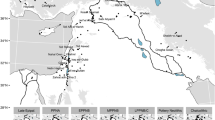Abstract
The transition from hunting gathering to a farming based economy – the Neolithic Revolution, was a crucial junction in the human career, attracting the attention of many scholars: archaeologists, anthropologists, geographers, botanists, geneticists and evolutionists among others. Our understanding of this major transformation is rather limited mainly due to the inability to fully reconstruct the cultural, biological and environmental setup of the relevant period and organisms involved. Many students of the subject of plant domestication have seriously entertained the hypothesis that man's first crop plants have originated from weeds associated with the disturbed habitats surrounding pre-agricultural ancient human dwellings and or with human refuse heaps – the so called ‘dump heap hypothesis’. In this paper we re-examine this hypothesis in light of the known biology of the Near Eastern founder crops and the ecological preferences of their wild progenitors. Contrary to the ‘dump-heap hypothesis’, we propose that Near Eastern farming originated as a result of a long term interaction between humans and plants and was mainly driven by the nutritional features of the respective crops and cultural forces.
Similar content being viewed by others
References
E. Anderson (1952) Plants, Man and Life LittleBrown and Co. Boston
O. Bar-Yosef R.H. Meadow (1995) The origins of agriculture in the Near East T.D. Price A.B. Gebauer (Eds) Last Hunters – First Farmers: New Perspectives on the Prehistoric Transition to Agriculture School of American Research Press Santa Fe 39–94
L.R. Binford (1968) Post Pleistocene adaptations L.R. Binford S.R. Binford (Eds) New Perspectives in Archaeology Aldine Chicago 313–341
M.A. Blumler (1991) ArticleTitleModelling the origins of legume domestication and cultivation Econ. Bot. 45 243–250
V.G. Childe (1951) Man Makes Himself The New American Library of World Literature New York and Toronto
J. Cauvin (2000) The Birth of the Gods and the Origin of Agriculture Cambridge University Press Cambridge
C.D. Darlington (1963) Chromosome Botany and the Origin of Cultivated Plants George Allen and Unwin Ltd London
T.H. Engelbrecht (1916) ArticleTitleÜber die Entstehung einiger feldmäßig angebauter Kulturpflanzen Georg. Z. 22 328–334
L.T. Evans (1993) Crop Evolution, Adaptation and Yield Cambridge University Press Cambridge
J.R. Harlan (1965) ArticleTitleThe possible role of weed races in the evolution of cultivated plants Euphytica 14 173–176 Occurrence Handle10.1007/BF00038984
J.R. Harlan (1992) Crops and Man EditionNumber2 American Society of Agronomy and Crop Science Society of America Madison
J.R. Harlan (1995) The Living Fields: Our Agricultural Heritage Cambridge University Press Cambridge
J.R. Harlan J.M.J. deWet (1965) ArticleTitleSome thoughts about weeds Econ. Bot 19 16–24
D.R. Harris (1969) Agricultural systems, ecosystems and the origins of agriculture P.J. Ucko G.W. Dimbleby (Eds) The Domestication and Exploitation of Plants and Animals Gerald Duckworth and Co London 3–15
J.G. Hawkes (1969) The ecological background of plant domestication P.J. Ucko G.W. Dimbleby (Eds) The Domestication and Exploitation of Plants and Animals Gerald Duckworth and Co London 17–29
J.G. Hawkes (1983) The Diversity of Crop Plants Harvard University Press Cambridge 1–46
B. Hayden (1990) ArticleTitleNimrods, piscators, pluckers and planters: the emergence of food production J. Anthropol. Archaeol. 9 31–69 Occurrence Handle10.1016/0278-4165(90)90005-X
G.C. Hillman M.S. Davies (1999) Domestication rate in wild wheats and barley under primitive cultivation P.C. Anderson (Eds) Prehistory of AgricultureNew Experimental and Ethnographic Approaches. Monograph 40 University of California Los Angeles 70–102
L. Holm J. Doll E. Holm J. Pancho H. Herberger (1997) World Weeds John Wiley and Sons, Inc. New York
G. Ladizinsky (1993) ArticleTitleLentil domestication: on the quality of evidence and arguments Econ. Bot. 47 60–64
S. Lev-Yadun A. Gopher S. Abbo (2000) ArticleTitleThe cradle of agriculture Science 288 1602–1603 Occurrence Handle10.1126/science.288.5471.1602 Occurrence Handle10858140
T.J. Monaco S.C. Weller F.M. Ashton (2002) Weed Science Principles and Practices. 4th ed John Wiley and Sons, Inc. NY
I. Noy-Meir D.D. Briske (1996) ArticleTitleFitness components of grazing-induced population reduction in a dominant annual, Triticum dicoccoides (wild wheat) J. Ecol. 84 439–448
I. Noy-Meir D.D. Briske (2002) ArticleTitleResponse of wild wheat populations to grazing in Mediterranean grasslands: the relative influence of defoliation, competition, mulch and genotype J. Appl. Ecol. 39 259–278 Occurrence Handle10.1046/j.1365-2664.2002.00707.x
C.L. Redman (1978) The Rise of Civilization: Early Farmers to Early Urban Sciety in the Near East Freeman San Francisco
D. Rindos (1984) The Origin of Agriculture: an Evolutionary Perspective Academic Press New York
T.O. Robson P.J. Americanos B.E. Abu-Irmaileh (1991) Major Weeds of the Near East FAO Rome
C.O. Sauer (1952) Seeds, Spades, Hearths, and Herds. The Domestication of Animals and Foodstuffs The MIT Press Cambridge
N.I. Vavilov (1951) The Origin, Variation, Immunity and Breeding of Cultivated Plants The Ronald Press Co. New York
W.K. Vencill (2002) Herbicide Handbook. 8th ed Weed Science Society of America Lawrence
A.C. Zeven (1973) ArticleTitleDr Engelbrecht's view on the origin of cultivated plants Euphytica 22 279–286 Occurrence Handle10.1007/BF00022636
D. Zohary M. Hopf (2000) Domestication of Plants in the Old World3rd ed Clarendon Press Oxford
M. Zohary (1973) Geobotanical Foundations of the Middle East Gustav Fischer Verlag Stuttgart
Author information
Authors and Affiliations
Corresponding author
Rights and permissions
About this article
Cite this article
Abbo, S., Gopher, A., Rubin, B. et al. On the Origin of Near Eastern Founder Crops and the ‘Dump-heap Hypothesis’. Genet Resour Crop Evol 52, 491–495 (2005). https://doi.org/10.1007/s10722-004-7069-x
Received:
Accepted:
Issue Date:
DOI: https://doi.org/10.1007/s10722-004-7069-x




